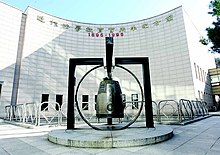| Seoul National University School of Law | |
|---|---|
 The Bell of Justice in front of the Centennial Building of School of Law The Bell of Justice in front of the Centennial Building of School of Law | |
| Parent school | Seoul National University |
| Established | 1895; 130 years ago (1895) |
| School type | National law school |
| Dean | Kim Jong-bo |
| Location | Gwanak, Seoul, South Korea 37°27′45″N 126°57′06″E / 37.46250°N 126.95167°E / 37.46250; 126.95167 |
| Enrollment | 1194 |
| Faculty | 60 |
| Website | law.snu.ac.kr |
| Seoul National University School of Law | |
| Hangul | 서울대학교 법학전문대학원 |
|---|---|
| Hanja | 서울大學校 法學専門大學院 |
| Revised Romanization | Seoul-daehakgyo Beophak-jeonmundaehagwon |
| McCune–Reischauer | Sŏul-daehakkyo Pŏphak-chŏnmundaehagwŏn |
Seoul National University School of Law (Korean: 서울대학교 법학전문대학원; SNU Law) is the law school of Seoul National University, a national research university in Gwanak, Seoul, South Korea.
Following legacy of the only and the first modern national law school established in 1895 as 'Popkwan Yangsungso' (Korean: 법관양성소) for training judges, the SNU Law started its official history at 1946 in name of SNU College of Law, as one of college constituting the Seoul National University, offering continental styled legal education such as LL.B. courses for undergraduates.
After nationwide legal education reform of South Korea in 2009, it adopted the American model of 3-year law school system, and changed its official name to SNU School of Law. It currently offers the J.D., J.S.D., LL.M., and Ph.D. degrees in law, and no longer admits undergraduate law students. Currently, number of admmission to J.D. course is limited to 150 students per year as numerus clausus, under national government's policy to keep number of enrollments in sustainable level.
History
The law school was established in its first iteration in 1895 during the Joseon Dynasty as the Judicial Officials Training Institute. Following the Gabo Reform, intended to be a sweeping reform of the Korean government, then-minister of justice Suh Kwangbom proposed creating and institution to educate judicial law. Initially, the institute served men between the ages of 25 and 30, and granted a bachelor of law.
In 1909, the institute was restructured, becoming a law school and a limited professional school. In 1911, the name and setup was again changed, and the school became Seoul Professional School. However, in 1922 it returned to being exclusively a law school, and the name was once again changed to Seoul Professional Law School.
In the early 1940s, the law school was forced to cease admitting new students due to harsh wartime policies enacted by the Japanese; however, these policies were reverted following the end of the war, and enrollment returned to normal levels.
Following the April Revolution, a student-led revolution which would lead to the end of the autocratic regime of Syngman Ree, enrollment was sharply and suddenly reduced by the government from three hundred students to one hundred and sixty, based on its assumption that the law school was the center of the protests. Enrollment stayed at this level until recovering in 1981.
Library
Established in August 1946, the Seoul National University Law Library opened on June 30, 2014. It currently holds more than 155,055 volumes in its collection.
Notable people
Alumni
See also: Category:Seoul National University School of Law alumniSNU Law School's long history and outstanding status inside South Korea created numerous notable alumni around Government of South Korea including judiciary, for example, 13th President of South Korea Yoon Suk-yeol, and most of Justices and Chief Justices of the Supreme Court of Korea, such as 16th Chief Justice Kim Myeong-soo. Also, most of Justices and Presidents of the Constitutional Court of Korea are composed of SNU Law alumni, including 7th President of the Constitutional Court Yoo Nam-seok.
Criticism
The SNU Law School has been criticized due to the lack of admitted students older than 30 years of age. The Law School was also criticized for having admitted 88.0% (810) of its students from the top three colleges of South Korea.
See also
References
- This building was built in year 1996, for celebrating more than 100 years history of modern legal education in Korea. See "근대법학교육 백주년기념관 봉헌사". December 18, 1996. Retrieved 2022-05-10.
- ^ "SNU Facts". SNU Law School. SNU. Retrieved 2022-05-10.
- "History, Introduction". SNU Law School. SNU. Retrieved 2022-04-28.
- "SNU Law". law.snu.ac.kr. Retrieved 2017-08-07.
- "Law Library" (in Korean). Seoul National University Library. Retrieved 2022-05-09.
- 30세이상 합격 0명.. 서울대 로스쿨 '연령차별' 문화일보, 2013년 6월 11일
- "서울대 로스쿨, 88%가 'SKY' 출신". view.asiae.co.kr. Retrieved 2015-07-04.
External links
| Law schools in South Korea | |
|---|---|